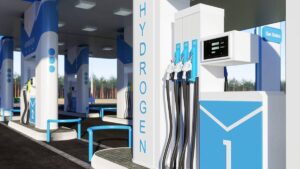Is green steel the driver for hydrogen adoption?

Pic: Yuichiro Chino / Moment via Getty Images
As the Chinese saying goes, a journey of a thousand miles begins with a single step, and that is true for nearly any new industry such as hydrogen.
While hydrogen has traditionally been used for ammonia and methanol production along with petroleum refining, food processing and metalworking, it is the use of hydrogen to displace other processes that is key to the development of a hydrogen industry.
Green steel, that is steel produced using hydrogen – preferably green hydrogen produced using renewable energy – could well be that first step that will see hydrogen being used for a wide range of applications including replacing fossil fuels for power and transportation.
Using hydrogen to separate oxygen from iron in the ore rather than using coking coal has the potential to slash emissions significantly or completely.
This is potentially very significant as iron and steel production is estimated to account for some 7% of the world’s total CO2 emissions.
The technology has already been proven by the pilot-scale Hybrit plant in Sweden, which has been producing steel since August 2020.
Proponents of green steel include Australia’s second richest person Dr Andrew Forrest, who has proposed the development of green steel sector in Australia.
Not only will this generate export revenue and create jobs, green steel could also jump start the country’s hydrogen industry by providing significant demand.
The iron ore mogul has also been pushing hard on green hydrogen, recently criticising Woodside and Santos for investing in hydrogen fuelled by natural gas, or blue hydrogen.
Infinite Blue Energy told Stockhead that with global trends putting pressure on companies to reduce emissions, it is inevitable that products like green steel will see increasing demand.
“Undoubtably our view is that there will be markets that would be willing to pay a premium for a cleaner product and whilst the total market segments may be small to commence with, I believe there will be demand for the product,” senior commercial manager Izzi Messina said.
Pure Hydrogen (ASX:PH2) managing director Scott Brown is a little more cautious, noting that while Dr Forrest is pretty aggressive about pushing green steel, he suspected that it wouldn’t be until 2030 before it came into vogue.
This timing could be dependent on the government giving industries a ‘green’ credit for reducing emissions, which would effectively be a form of assistance.
“If there’s no government scheme, then I suspect it will take longer as it would have to compete with steel from China, India or some other place that used traditional methods.”
However, he noted that while Australian steel producers were pretty small, they could also show the way forward for the industry.
“If Forrest wants to show us the way by putting some of his own hard earned money into a mill, he’s got the iron ore, we can provide him the hydrogen he wants,” Brown added.
Green or blue hydrogen for green steel
Separately, Hexagon Energy Materials (ASX:HXG) noted that as hydrogen needs to be priced below US$1.50 per kilogram for green steel to be economically viable, the cost of producing green hydrogen – current about US$6 per kg – means that the initial switch might be made using blue hydrogen (US$2/kg).
“To start to tackle CO2 emissions now, the push needs to be on blue hydrogen which is cheaper and so will have greater uptake but with exactly the same emissions profile of green hydrogen,” the company claimed.
“In time the costs of green hydrogen will come down to that of blue hydrogen and the two clean products will co-exist in the hydrogen economy of tomorrow.”
Blue hydrogen has been derided by green hydrogen purists who say that the only way forward is to use renewable energy to crack water into hydrogen and oxygen.
However, blue hydrogen proponents have put forward a number of ways to address the carbon dioxide emissions resulting from cracking methane or gasifying coal.
Hexagon has proposed to either sequester the captured CO2 in reservoirs or to use it for enhanced oil recovery while Pure Hydrogen’s process sidesteps the issue by creating solid carbon products such as synthetic graphite or graphene rather than CO2.
Driving the hydrogen industry
Green steel may very well be one prong of the effort that brings the hydrogen industry into the mainstream but how else will the fuel of the future take flight?
Hexagon stated its belief that the biggest driver for the growth of the hydrogen industry would be the build-out of infrastructure to make the handling, storage and transportation of the gas easier.
Brown was a little more specific saying that the use of hydrogen as fuel for trucks would be key.
“We are already doing studies for large companies. We have shown them that we cut about 27% of their fuel bill from what they pay for diesel today if they switched over to hydrogen trucks,” he told Stockhead.
“A truck might use 20kg to 30kg of hydrogen per day, which means a facility can make a decent profit making hydrogen for 20 to 30 trucks,” Brown explained.
And it is not just long-haul trucks either.
Brown believes that back to base operations like rubbish trucks, which stop and start a lot and have an electric arm, and concrete trucks with their big agitators could also be powered by hydrogen.
At Stockhead we tell it like it is. While Infinite Blue Energy, Hexagon Energy Materials and Pure Hydrogen are Stockhead advertisers, they did not sponsor this article.

UNLOCK INSIGHTS
Discover the untold stories of emerging ASX stocks.
Daily news and expert analysis, it's free to subscribe.
By proceeding, you confirm you understand that we handle personal information in accordance with our Privacy Policy.








